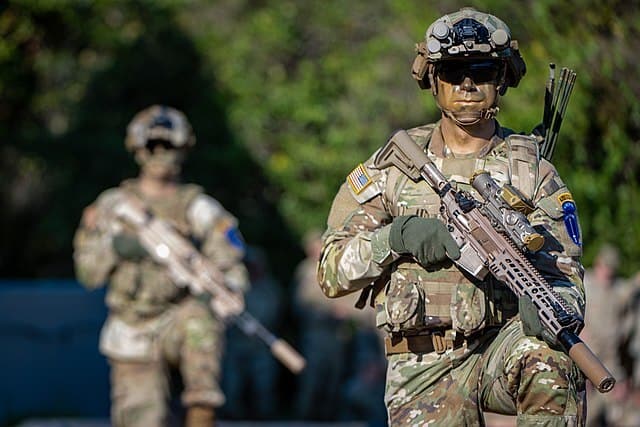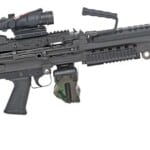
Introduction
Military weaponry has always played a decisive role in shaping battlefield outcomes. Throughout history, the United States has remained at the forefront of small arms development, continuously refining its arsenal to meet the demands of modern combat. The latest breakthrough in this evolution is the U.S. Army’s Next Generation Squad Weapon (NGSW) Program, which has introduced two revolutionary firearms—the XM7 Rifle and the XM250 Automatic Rifle. These weapons mark a significant departure from previous infantry arms, leveraging new ammunition technology, enhanced lethality, and improved soldier effectiveness.
Historical Evolution of U.S. Military Small Arms
The history of U.S. military firearms is defined by major technological leaps. From the Springfield Model 1903 bolt-action rifle to the M1 Garand, the introduction of semi-automatic capabilities changed the face of war. The M16, adopted during the Vietnam War, brought a lightweight design and high-velocity 5.56×45mm NATO cartridge, leading to the eventual adoption of the M4 Carbine and the M249 Squad Automatic Weapon (SAW).
However, recent developments in body armor technology and shifting battlefield conditions exposed deficiencies in the 5.56mm cartridge, particularly in terms of effective range and penetration. Recognizing this, the U.S. Army launched the Next Generation Squad Weapon Program (NGSW) in 2019 to replace the M4A1 Carbine and M249 SAW with superior alternatives.
The Next Generation Squad Weapon Program (NGSW)
The NGSW Program sought to create a more lethal and adaptable weapon system that could outperform current service rifles and machine guns. The primary goal was to field weapons chambered in the new 6.8×51mm SIG Fury cartridge, offering greater range, penetration, and energy transfer compared to both 5.56×45mm and 7.62×51mm NATO rounds.
After extensive trials, SIG Sauer was awarded a 10-year contract in April 2022 to produce the new firearms: the XM7 Rifle and XM250 Automatic Rifle.
XM7 Rifle: A Detailed Breakdown
The XM7, derived from the SIG MCX Spear, represents a fundamental shift in individual soldier armament. Unlike the M4, the XM7 utilizes a short-stroke gas piston system, improving reliability over traditional direct impingement systems. The weapon is built with modern enhancements tailored for enhanced modularity, durability, and combat effectiveness.
Key Features of the XM7 Rifle:
- Caliber: 6.8×51mm SIG Fury
- Action: Gas-operated, short-stroke piston
- Weight: 8.38 lbs (3.80 kg) (9.84 lbs with suppressor)
- Magazine Capacity: 20-round SR-25 pattern magazine (optional 25-round)
- Effective Range: ~600 meters
- Fire Rate: Select-fire (semi-automatic, fully automatic)
- Barrel Length: 13 inches
- Suppressor: Integrated design for reduced flash and sound signature
- Handguard: Free-floating, M-LOK-compatible for direct accessory attachment
- Optics: Designed to integrate the XM157 Fire Control System by Vortex Optics
XM7 vs. M4A1: A Critical Comparison
The XM7 differs significantly from the M4A1, both in size and performance:
- Increased Weight: While the XM7 weighs nearly two pounds more than the M4A1, this tradeoff comes with enhanced ballistics and range.
- More Lethal Ammunition: The 6.8×51mm SIG Fury offers 40–50% more energy than 5.56mm rounds, enabling superior armor penetration.
- Modular Design: The free-floating M-LOK handguard allows for direct mounting of accessories, improving adaptability.
- Integrated Fire Control System: The XM157 optic features a ballistic computer, rangefinder, and infrared targeting, effectively doubling hit probability at 300 meters.
Civilian Counterpart: The SIG MCX-Spear
For civilians, SIG Sauer has introduced the MCX-Spear, a semi-automatic variant of the XM7, chambered in 7.62×51mm NATO (.308) instead of 6.8×51mm due to ammunition restrictions.
XM250 Automatic Rifle: The Future of Squad Firepower
Replacing the M249 SAW, the XM250 offers superior mobility, accuracy, and lethality. Unlike the belt-fed 5.56mm M249, the XM250 fires the 6.8×51mm SIG Fury, ensuring greater stopping power at extended ranges.
Key Features of the XM250 Automatic Rifle:
- Caliber: 6.8×51mm SIG Fury
- Action: Gas-operated, belt-fed
- Weight: 13 lbs (5.9 kg) (14.5 lbs with suppressor)
- Fire Rate: Fully automatic, 600 rounds per minute
- Ammunition Load: Standard combat load: 400 rounds (4 × 100-round belts)
- Suppressor: Included for reduced noise and muzzle flash
- Accuracy: Increased due to advanced optical targeting systems
XM250 vs. M249 SAW: Notable Improvements
- Lighter Design: Weighing 4 lbs less than the M249, making it easier for soldiers to maneuver in combat.
- More Powerful Ammunition: 6.8×51mm rounds offer better range and penetration than 5.56mm belts.
- Integrated Suppression: Unlike the M249, the XM250 is designed with a suppressor in mind, reducing flash and noise signature.
- Improved Optics Compatibility: Designed for the XM157 Fire Control System, enhancing target acquisition.
Testing and Deployment
Before widespread adoption, both the XM7 and XM250 must pass rigorous tests:
- Production Qualification Test (PQT): Ensures manufacturing consistency and quality.
- Operational Testing (OT): Evaluates real-world battlefield performance.
The first XM7 and XM250 units were delivered in 2023, but full adoption depends on further evaluation. Current projections suggest full-scale deployment by 2025, provided the tests yield satisfactory results.
Challenges and Considerations
1. Increased Ammunition Weight
- A combat load of 140 rounds (XM7) weighs 9.8 lbs, compared to 210 rounds (M4) weighing ~7 lbs.
- Soldiers may need to carry fewer rounds or accept greater overall load.
2. Maintenance and Durability
- The hybrid case 6.8mm round operates at ~80,000 psi, nearly double the pressure of traditional cartridges, requiring enhanced barrel and bolt durability.
- Extensive use of suppressors may increase carbon fouling, necessitating frequent maintenance.
3. Adoption by Special Operations Forces
While SOCOM has shown interest in the XM7 and XM250, there is no formal commitment yet. Current SOF units continue to use MCX Rattlers, HK416s, and MK18 rifles until further evaluations are complete.
The Future of Infantry Warfare
The XM7 and XM250 represent the most significant leap in U.S. small arms technology in decades. With enhanced lethality, improved optics, and modular design, these weapons are poised to redefine infantry effectiveness for years to come. As testing continues, the ultimate question remains: will these weapons prove as revolutionary in combat as their predecessors? If so, they may set the new global standard for military firearms.
Here's a link to the official announcement from the US Army.
If you know of any forums or sites that should be referenced on this listing, please let us know here.




